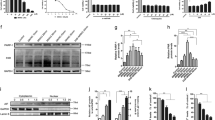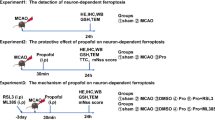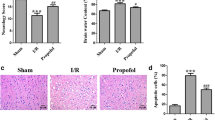Abstract
Oxidative stress caused by mitochondrial dysfunction during reperfusion is a key pathogenic mechanism in cerebral ischemia–reperfusion (IR) injury. Propofol (2,6-diisopropylphenol) has been proven to attenuate mitochondrial dysfunction and reperfusion injury. The current study reveals that propofol decreases oxidative stress injury by preventing succinate accumulation in focal cerebral IR injury. We evaluated whether propofol could attenuate ischemic accumulation of succinate in transient middle cerebral artery occlusion in vivo. By isolating mitochondria from cortical tissue, we also examined the in vitro effects of propofol on succinate dehydrogenase (SDH) activity and various mitochondrial bioenergetic parameters related to oxidative stress injury, such as the production of reactive oxidative species, membrane potential, Ca2+-induced mitochondrial swelling, and morphology via electron microscopy. Propofol significantly decreased the ischemic accumulation of succinate by inhibiting SDH activity and inhibited the oxidation of succinate in mitochondria. Propofol can decrease membrane potential in normal mitochondria but not in ischemic mitochondria. Propofol prevents Ca2+-induced mitochondrial swelling and ultrastructural changes to mitochondria. The protective effect of propofol appears to act, at least in part, by limiting oxidative stress injury by preventing the ischemic accumulation of succinate.





Similar content being viewed by others
References
Hausenloy DJ, Yellon DM (2013) Myocardial ischemia-reperfusion injury: a neglected therapeutic target. J Clin Invest 123(1):92–100. https://doi.org/10.1172/JCI62874
Hausenloy DJ, Yellon DM (2016) Ischaemic conditioning and reperfusion injury. Nat Rev Cardiol 13(4):193–209. https://doi.org/10.1038/nrcardio.2016.5
Suliman HB, Piantadosi CA (2016) Mitochondrial quality control as a therapeutic target. Pharmacol Rev 68(1):20–48. https://doi.org/10.1124/pr.115.011502
Eltzschig HK, Eckle T (2011) Ischemia and reperfusion—from mechanism to translation. Nat Med 17(11):1391–1401. https://doi.org/10.1038/nm.2507
Chouchani ET, Pell VR, Gaude E, Aksentijevic D, Sundier SY, Robb EL, Logan A, Nadtochiy SM, Ord EN, Smith AC, Eyassu F, Shirley R, Hu CH, Dare AJ, James AM, Rogatti S, Hartley RC, Eaton S, Costa AS, Brookes PS, Davidson SM, Duchen MR, Saeb-Parsy K, Shattock MJ, Robinson AJ, Work LM, Frezza C, Krieg T, Murphy MP (2014) Ischaemic accumulation of succinate controls reperfusion injury through mitochondrial ROS. Nature 515(7527):431–435. https://doi.org/10.1038/nature13909
Chouchani ET, Pell VR, James AM, Work LM, Saeb-Parsy K, Frezza C, Krieg T, Murphy MP (2016) A unifying mechanism for mitochondrial superoxide production during ischemia-reperfusion injury. Cell Metab 23(2):254–263. https://doi.org/10.1016/j.cmet.2015.12.009
Dhingra R, Kirshenbaum LA (2015) Succinate dehydrogenase/complex II activity obligatorily links mitochondrial reserve respiratory capacity to cell survival in cardiac myocytes. Cell Death Dis 6:e1956. https://doi.org/10.1038/cddis.2015.310
Iijima T, Mishima T, Akagawa K, Iwao Y (2006) Neuroprotective effect of propofol on necrosis and apoptosis following oxygen-glucose deprivation–relationship between mitochondrial membrane potential and mode of death. Brain Res 1099(1):25–32. https://doi.org/10.1016/j.brainres.2006.04.117
Shao H, Li J, Zhou Y, Ge Z, Fan J, Shao Z, Zeng Y (2008) Dose-dependent protective effect of propofol against mitochondrial dysfunction in ischaemic/reperfused rat heart: role of cardiolipin. Br J Pharmacol 153(8):1641–1649. https://doi.org/10.1038/bjp.2008.45
Adembri C, Venturi L, Tani A, Chiarugi A, Gramigni E, Cozzi A, Pancani T, De Gaudio RA, Pellegrini-Giampietro DE (2006) Neuroprotective effects of propofol in models of cerebral ischemia: inhibition of mitochondrial swelling as a possible mechanism. Anesthesiology 104(1):80–89
Li J, Han B, Ma X, Qi S (2010) The effects of propofol on hippocampal caspase-3 and Bcl-2 expression following forebrain ischemia-reperfusion in rats. Brain Res 1356:11–23. https://doi.org/10.1016/j.brainres.2010.08.012
Wang HY, Wang GL, Yu YH, Wang Y (2009) The role of phosphoinositide-3-kinase/Akt pathway in propofol-induced postconditioning against focal cerebral ischemia-reperfusion injury in rats. Brain Res 1297:177–184. https://doi.org/10.1016/j.brainres.2009.08.054
Yano T, Nakayama R, Ushijima K (2000) Intracerebroventricular propofol is neuroprotective against transient global ischemia in rats: extracellular glutamate level is not a major determinant. Brain Res 883(1):69–76
Li J, Yu W, Li XT, Qi SH, Li B (2014) The effects of propofol on mitochondrial dysfunction following focal cerebral ischemia-reperfusion in rats. Neuropharmacology 77:358–368. https://doi.org/10.1016/j.neuropharm.2013.08.029
Kajimoto M, Atkinson DB, Ledee DR, Kayser EB, Morgan PG, Sedensky MM, Isern NG, Des Rosiers C, Portman MA (2014) Propofol compared with isoflurane inhibits mitochondrial metabolism in immature swine cerebral cortex. J Cereb Blood Flow Metab 34(3):514–521. https://doi.org/10.1038/jcbfm.2013.229
Kotani Y, Nakajima Y, Hasegawa T, Satoh M, Nagase H, Shimazawa M, Yoshimura S, Iwama T, Hara H (2008) Propofol exerts greater neuroprotection with disodium edetate than without it. J Cereb Blood Flow Metab 28(2):354–366. https://doi.org/10.1038/sj.jcbfm.9600532
Sims NR, Anderson MF (2008) Isolation of mitochondria from rat brain using Percoll density gradient centrifugation. Nat Protoc 3(7):1228–1239. https://doi.org/10.1038/nprot.2008.105
Ashwal S, Tone B, Tian HR, Cole DJ, Pearce WJ (1998) Core and penumbral nitric oxide synthase activity during cerebral ischemia and reperfusion. Stroke 29(5):1037–1046 (discussion 1047)
Lee H, Jang YH, Lee SR (2005) Protective effect of propofol against kainic acid-induced lipid peroxidation in mouse brain homogenates: comparison with trolox and melatonin. J Neurosurg Anesthesiol 17(3):144–148
Yumoto M, Nishida O, Nakamura F, Katsuya H (2005) Propofol attenuates oxidant-induced acute lung injury in an isolated perfused rabbit-lung model. J Anesth 19(4):287–294. https://doi.org/10.1007/s00540-005-0338-9
Tsao CM, Ho ST, Chen A, Wang JJ, Tsai SK, Wu CC (2003) Propofol ameliorates liver dysfunction and inhibits aortic superoxide level in conscious rats with endotoxic shock. Eur J Pharmacol 477(2):183–193
Unsal A, Devrim E, Guven C, Eroglu M, Durak I, Bozoklu A, Balbay MD (2004) Propofol attenuates reperfusion injury after testicular torsion and detorsion. World J Urol 22(6):461–465. https://doi.org/10.1007/s00345-004-0451-7
Gonzalez-Perez O, Moy-Lopez NA, Guzman-Muniz J (2008) Alpha-tocopherol and alpha-lipoic acid. An antioxidant synergy with potential for preventive medicine. Rev Invest Clin 60(1):58–67
Wijermars LG, Schaapherder AF, Kostidis S, Wust RC, Lindeman JH (2016) Succinate accumulation and ischemia-reperfusion injury: of mice but not men, a study in renal ischemia-reperfusion. Am J Transplant 16(9):2741–2746. https://doi.org/10.1111/ajt.13793
O’Neill LA (2014) Biochemistry: succinate strikes. Nature 515(7527):350–351. https://doi.org/10.1038/nature13941
Muralikrishna Adibhatla R, Hatcher JF (2006) Phospholipase A2, reactive oxygen species, and lipid peroxidation in cerebral ischemia. Free Radic Biol Med 40(3):376–387. https://doi.org/10.1016/j.freeradbiomed.2005.08.044
Li SY, Jia YH, Sun WG, Tang Y, An GS, Ni JH, Jia HT (2010) Stabilization of mitochondrial function by tetramethylpyrazine protects against kainate-induced oxidative lesions in the rat hippocampus. Free Radic Biol Med 48(4):597–608. https://doi.org/10.1016/j.freeradbiomed.2009.12.004
Zorov DB, Juhaszova M, Sollott SJ (2014) Mitochondrial reactive oxygen species (ROS) and ROS-induced ROS release. Physiol Rev 94(3):909–950. https://doi.org/10.1152/physrev.00026.2013
Petronilli V, Costantini P, Scorrano L, Colonna R, Passamonti S, Bernardi P (1994) The voltage sensor of the mitochondrial permeability transition pore is tuned by the oxidation-reduction state of vicinal thiols. Increase of the gating potential by oxidants and its reversal by reducing agents. J Biol Chem 269(24):16638–16642
Kim JS, Jin Y, Lemasters JJ (2006) Reactive oxygen species, but not Ca2+ overloading, trigger pH- and mitochondrial permeability transition-dependent death of adult rat myocytes after ischemia-reperfusion. Am J Physiol Heart Circ Physiol 290(5):H2024–H2034. https://doi.org/10.1152/ajpheart.00683.2005
Assaly R, de Tassigny A, Paradis S, Jacquin S, Berdeaux A, Morin D (2012) Oxidative stress, mitochondrial permeability transition pore opening and cell death during hypoxia-reoxygenation in adult cardiomyocytes. Eur J Pharmacol 675(1–3):6–14. https://doi.org/10.1016/j.ejphar.2011.11.036
Clarke SJ, Khaliulin I, Das M, Parker JE, Heesom KJ, Halestrap AP (2008) Inhibition of mitochondrial permeability transition pore opening by ischemic preconditioning is probably mediated by reduction of oxidative stress rather than mitochondrial protein phosphorylation. Circ Res 102(9):1082–1090. https://doi.org/10.1161/CIRCRESAHA.107.167072
Zorov DB, Filburn CR, Klotz LO, Zweier JL, Sollott SJ (2000) Reactive oxygen species (ROS)-induced ROS release: a new phenomenon accompanying induction of the mitochondrial permeability transition in cardiac myocytes. J Exp Med 192(7):1001–1014
Schriewer JM, Peek CB, Bass J, Schumacker PT (2013) ROS-mediated PARP activity undermines mitochondrial function after permeability transition pore opening during myocardial ischemia-reperfusion. J Am Heart Assoc 2(2):e000159. https://doi.org/10.1161/JAHA.113.000159
Baines CP, Kaiser RA, Purcell NH, Blair NS, Osinska H, Hambleton MA, Brunskill EW, Sayen MR, Gottlieb RA, Dorn GW, Robbins J, Molkentin JD (2005) Loss of cyclophilin D reveals a critical role for mitochondrial permeability transition in cell death. Nature 434(7033):658–662. https://doi.org/10.1038/nature03434
Halestrap AP, Connern CP, Griffiths EJ, Kerr PM (1997) Cyclosporin A binding to mitochondrial cyclophilin inhibits the permeability transition pore and protects hearts from ischaemia/reperfusion injury. Mol Cell Biochem 174(1–2):167–172
Nakagawa T, Shimizu S, Watanabe T, Yamaguchi O, Otsu K, Yamagata H, Inohara H, Kubo T, Tsujimoto Y (2005) Cyclophilin D-dependent mitochondrial permeability transition regulates some necrotic but not apoptotic cell death. Nature 434(7033):652–658. https://doi.org/10.1038/nature03317
Schinzel AC, Takeuchi O, Huang Z, Fisher JK, Zhou Z, Rubens J, Hetz C, Danial NN, Moskowitz MA, Korsmeyer SJ (2005) Cyclophilin D is a component of mitochondrial permeability transition and mediates neuronal cell death after focal cerebral ischemia. Proc Natl Acad Sci USA 102(34):12005–12010. https://doi.org/10.1073/pnas.0505294102
Di Lisa F, Bernardi P (2006) Mitochondria and ischemia-reperfusion injury of the heart: fixing a hole. Cardiovasc Res 70(2):191–199. https://doi.org/10.1016/j.cardiores.2006.01.016
Halestrap AP (2009) Mitochondria and reperfusion injury of the heart–a holey death but not beyond salvation. J Bioenerg Biomembr 41(2):113–121. https://doi.org/10.1007/s10863-009-9206-x
Huttemann M, Pecina P, Rainbolt M, Sanderson TH, Kagan VE, Samavati L, Doan JW, Lee I (2011) The multiple functions of cytochrome c and their regulation in life and death decisions of the mammalian cell: from respiration to apoptosis. Mitochondrion 11(3):369–381. https://doi.org/10.1016/j.mito.2011.01.010
Gullans SR, Kone BC, Avison MJ, Giebisch G (1988) Succinate alters respiration, membrane potential, and intracellular K+ in proximal tubule. Am J Physiol 255(6 Pt 2):F1170–F1177
van Raam BJ, Sluiter W, de Wit E, Roos D, Verhoeven AJ, Kuijpers TW (2008) Mitochondrial membrane potential in human neutrophils is maintained by complex III activity in the absence of supercomplex organisation. PLoS ONE 3(4):e2013. https://doi.org/10.1371/journal.pone.0002013
Funding
This project was supported by a Grant from the Natural Science Foundation of China (No. 81271456).
Author information
Authors and Affiliations
Contributions
Study design: SQ, WY. Study conduct: DG, SL. Data analysis: WY, WJ. Writing paper: WY, SQ. Revising paper: all authors.
Corresponding author
Ethics declarations
Conflict of interest
The authors declare no competing interests.
Rights and permissions
About this article
Cite this article
Yu, W., Gao, D., Jin, W. et al. Propofol Prevents Oxidative Stress by Decreasing the Ischemic Accumulation of Succinate in Focal Cerebral Ischemia–Reperfusion Injury. Neurochem Res 43, 420–429 (2018). https://doi.org/10.1007/s11064-017-2437-z
Received:
Revised:
Accepted:
Published:
Issue Date:
DOI: https://doi.org/10.1007/s11064-017-2437-z




